BSc Business Management BMP4005: Information Systems & IT Solution
VerifiedAdded on 2023/06/14
|10
|3202
|165
Report
AI Summary
This report provides an overview of IT systems and solutions in contemporary business firms. It explains IT solutions such as McAfee and MS Office, detailing their design and development methodologies. The report covers the impact of IT on globalization, highlighting how technology facilitates international trade and communication. Additionally, it discusses the definition, advantages, and disadvantages of digital infrastructure, emphasizing its role in modern business operations. The report also addresses the risks associated with IT outsourcing and the critical importance of IT infrastructure in enabling digital transformation. The document is contributed by a student and available on Desklib, a platform offering study tools and resources.
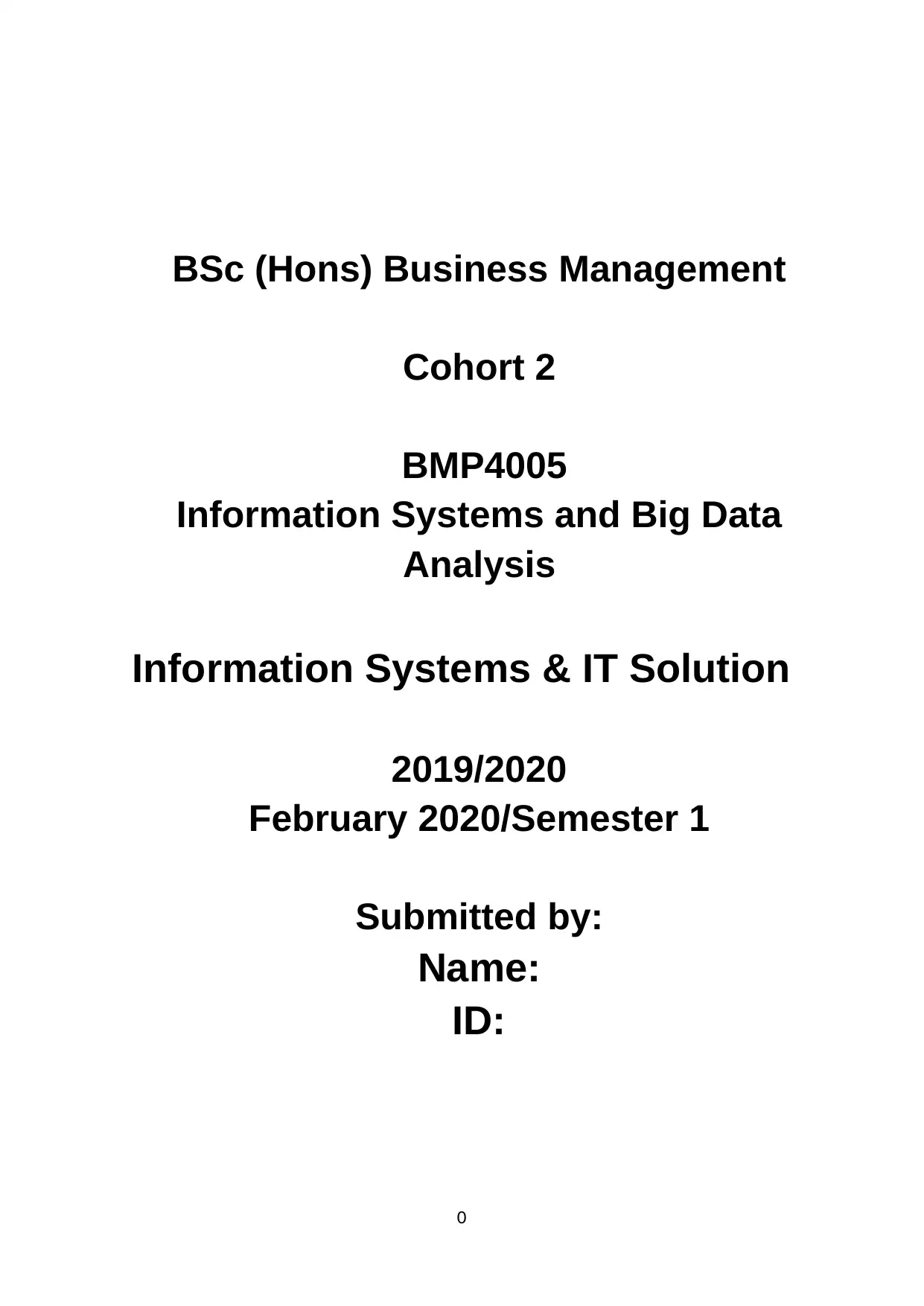
BSc (Hons) Business Management
Cohort 2
BMP4005
Information Systems and Big Data
Analysis
Information Systems & IT Solution
2019/2020
February 2020/Semester 1
Submitted by:
Name:
ID:
0
Cohort 2
BMP4005
Information Systems and Big Data
Analysis
Information Systems & IT Solution
2019/2020
February 2020/Semester 1
Submitted by:
Name:
ID:
0
Paraphrase This Document
Need a fresh take? Get an instant paraphrase of this document with our AI Paraphraser

Contents
Introduction 1
Task 1: Theories, methods and techniques which relate to
the design and development for TWO of the IT solutions
listed here: (i) McAfee; (ii) Moodle; (iii) Canvas; (iv) MS
Office 1
Task 2: Explanation of the systems below with relevant
examples 3
Task 3: Globalisation and the effects of IT on globalisation
4
Task 4: Definition, example, advantages and
disadvantages of digital infrastructure 5
Task 5: Risks associated with information systems
outsourcing and why is IT infrastructure so critical to
digital transformation! 6
Conclusion 7
References 8
Introduction
1
Introduction 1
Task 1: Theories, methods and techniques which relate to
the design and development for TWO of the IT solutions
listed here: (i) McAfee; (ii) Moodle; (iii) Canvas; (iv) MS
Office 1
Task 2: Explanation of the systems below with relevant
examples 3
Task 3: Globalisation and the effects of IT on globalisation
4
Task 4: Definition, example, advantages and
disadvantages of digital infrastructure 5
Task 5: Risks associated with information systems
outsourcing and why is IT infrastructure so critical to
digital transformation! 6
Conclusion 7
References 8
Introduction
1
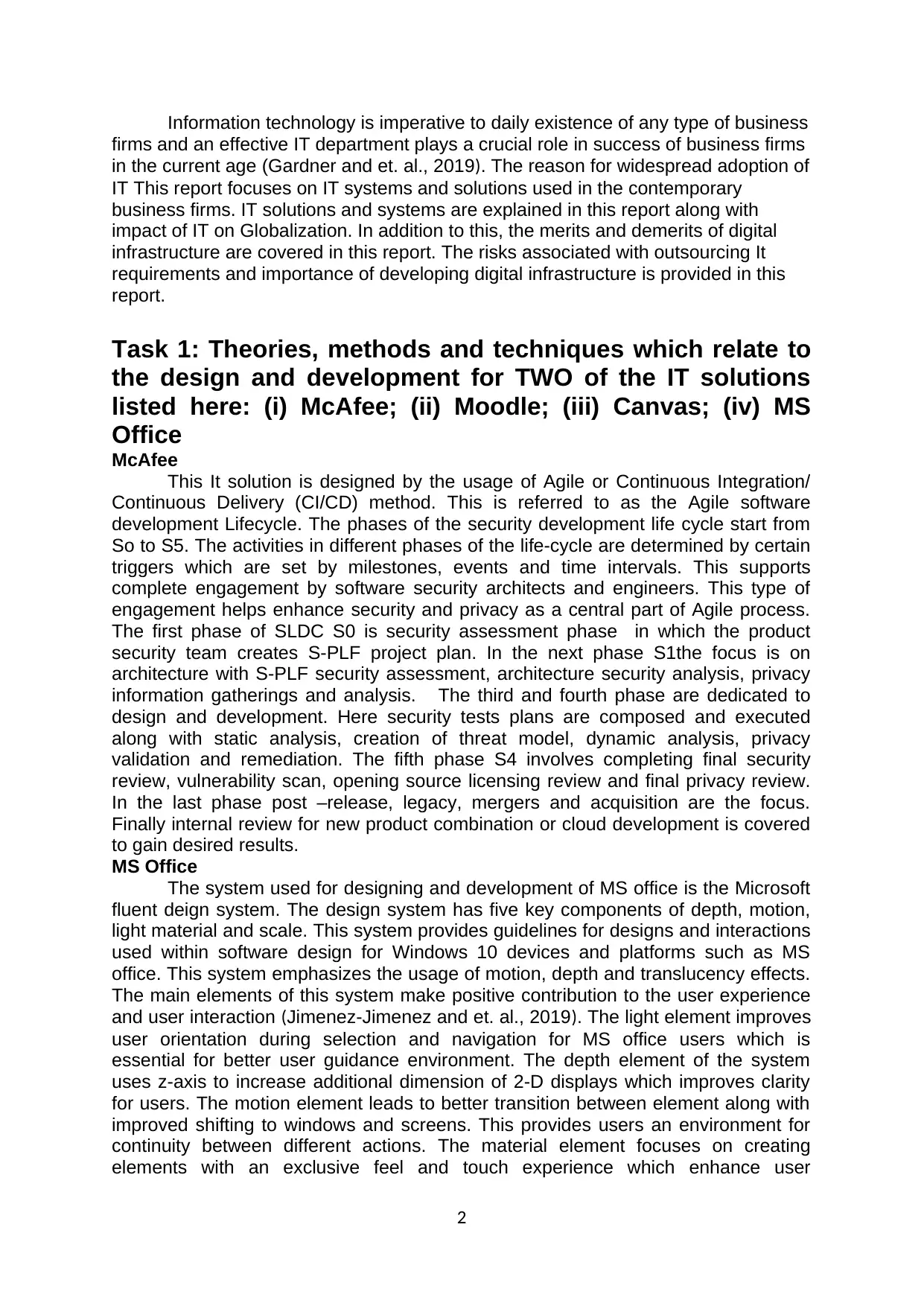
Information technology is imperative to daily existence of any type of business
firms and an effective IT department plays a crucial role in success of business firms
in the current age (Gardner and et. al., 2019). The reason for widespread adoption of
IT This report focuses on IT systems and solutions used in the contemporary
business firms. IT solutions and systems are explained in this report along with
impact of IT on Globalization. In addition to this, the merits and demerits of digital
infrastructure are covered in this report. The risks associated with outsourcing It
requirements and importance of developing digital infrastructure is provided in this
report.
Task 1: Theories, methods and techniques which relate to
the design and development for TWO of the IT solutions
listed here: (i) McAfee; (ii) Moodle; (iii) Canvas; (iv) MS
Office
McAfee
This It solution is designed by the usage of Agile or Continuous Integration/
Continuous Delivery (CI/CD) method. This is referred to as the Agile software
development Lifecycle. The phases of the security development life cycle start from
So to S5. The activities in different phases of the life-cycle are determined by certain
triggers which are set by milestones, events and time intervals. This supports
complete engagement by software security architects and engineers. This type of
engagement helps enhance security and privacy as a central part of Agile process.
The first phase of SLDC S0 is security assessment phase in which the product
security team creates S-PLF project plan. In the next phase S1the focus is on
architecture with S-PLF security assessment, architecture security analysis, privacy
information gatherings and analysis. The third and fourth phase are dedicated to
design and development. Here security tests plans are composed and executed
along with static analysis, creation of threat model, dynamic analysis, privacy
validation and remediation. The fifth phase S4 involves completing final security
review, vulnerability scan, opening source licensing review and final privacy review.
In the last phase post –release, legacy, mergers and acquisition are the focus.
Finally internal review for new product combination or cloud development is covered
to gain desired results.
MS Office
The system used for designing and development of MS office is the Microsoft
fluent deign system. The design system has five key components of depth, motion,
light material and scale. This system provides guidelines for designs and interactions
used within software design for Windows 10 devices and platforms such as MS
office. This system emphasizes the usage of motion, depth and translucency effects.
The main elements of this system make positive contribution to the user experience
and user interaction (Jimenez-Jimenez and et. al., 2019). The light element improves
user orientation during selection and navigation for MS office users which is
essential for better user guidance environment. The depth element of the system
uses z-axis to increase additional dimension of 2-D displays which improves clarity
for users. The motion element leads to better transition between element along with
improved shifting to windows and screens. This provides users an environment for
continuity between different actions. The material element focuses on creating
elements with an exclusive feel and touch experience which enhance user
2
firms and an effective IT department plays a crucial role in success of business firms
in the current age (Gardner and et. al., 2019). The reason for widespread adoption of
IT This report focuses on IT systems and solutions used in the contemporary
business firms. IT solutions and systems are explained in this report along with
impact of IT on Globalization. In addition to this, the merits and demerits of digital
infrastructure are covered in this report. The risks associated with outsourcing It
requirements and importance of developing digital infrastructure is provided in this
report.
Task 1: Theories, methods and techniques which relate to
the design and development for TWO of the IT solutions
listed here: (i) McAfee; (ii) Moodle; (iii) Canvas; (iv) MS
Office
McAfee
This It solution is designed by the usage of Agile or Continuous Integration/
Continuous Delivery (CI/CD) method. This is referred to as the Agile software
development Lifecycle. The phases of the security development life cycle start from
So to S5. The activities in different phases of the life-cycle are determined by certain
triggers which are set by milestones, events and time intervals. This supports
complete engagement by software security architects and engineers. This type of
engagement helps enhance security and privacy as a central part of Agile process.
The first phase of SLDC S0 is security assessment phase in which the product
security team creates S-PLF project plan. In the next phase S1the focus is on
architecture with S-PLF security assessment, architecture security analysis, privacy
information gatherings and analysis. The third and fourth phase are dedicated to
design and development. Here security tests plans are composed and executed
along with static analysis, creation of threat model, dynamic analysis, privacy
validation and remediation. The fifth phase S4 involves completing final security
review, vulnerability scan, opening source licensing review and final privacy review.
In the last phase post –release, legacy, mergers and acquisition are the focus.
Finally internal review for new product combination or cloud development is covered
to gain desired results.
MS Office
The system used for designing and development of MS office is the Microsoft
fluent deign system. The design system has five key components of depth, motion,
light material and scale. This system provides guidelines for designs and interactions
used within software design for Windows 10 devices and platforms such as MS
office. This system emphasizes the usage of motion, depth and translucency effects.
The main elements of this system make positive contribution to the user experience
and user interaction (Jimenez-Jimenez and et. al., 2019). The light element improves
user orientation during selection and navigation for MS office users which is
essential for better user guidance environment. The depth element of the system
uses z-axis to increase additional dimension of 2-D displays which improves clarity
for users. The motion element leads to better transition between element along with
improved shifting to windows and screens. This provides users an environment for
continuity between different actions. The material element focuses on creating
elements with an exclusive feel and touch experience which enhance user
2
⊘ This is a preview!⊘
Do you want full access?
Subscribe today to unlock all pages.

Trusted by 1+ million students worldwide
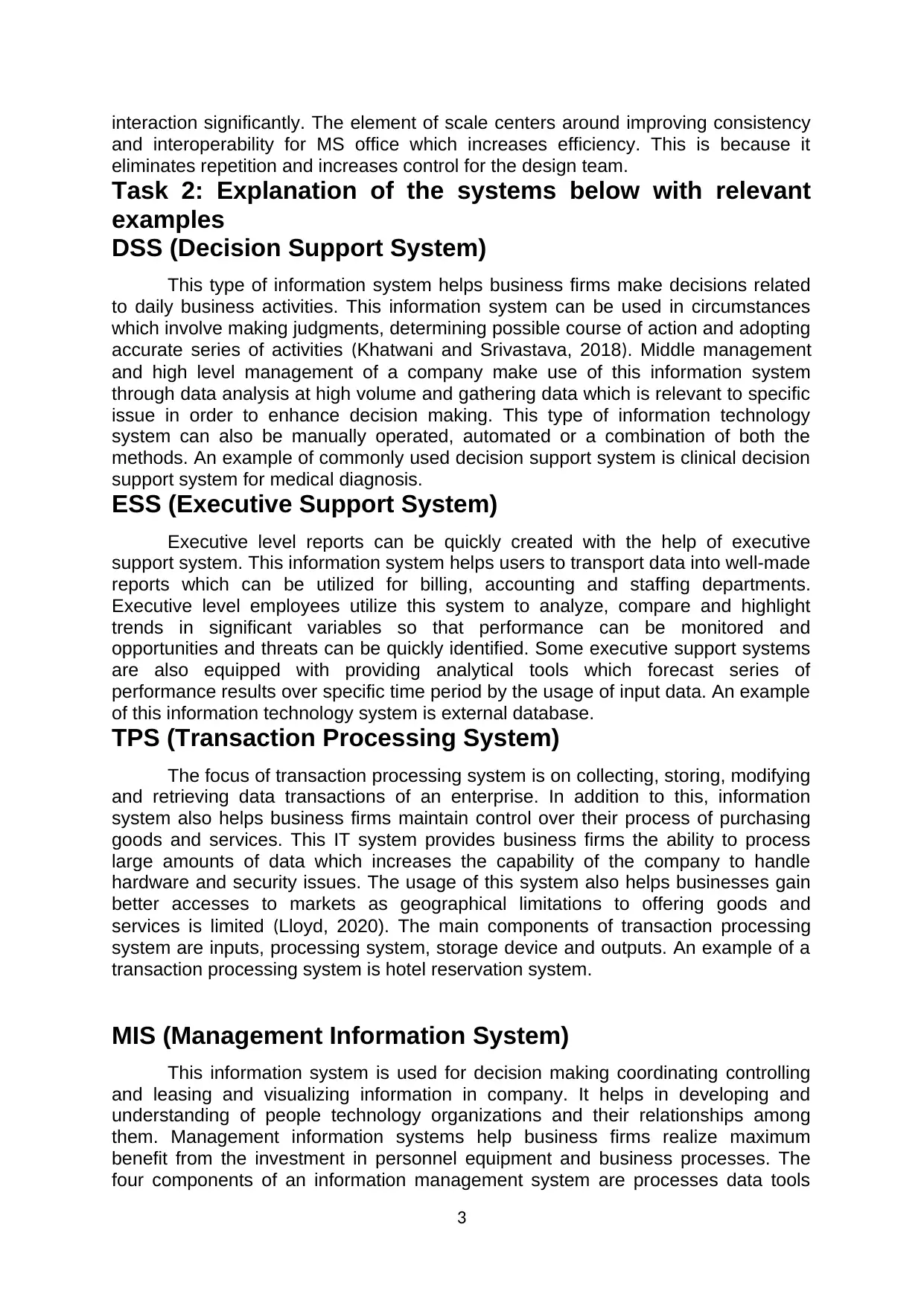
interaction significantly. The element of scale centers around improving consistency
and interoperability for MS office which increases efficiency. This is because it
eliminates repetition and increases control for the design team.
Task 2: Explanation of the systems below with relevant
examples
DSS (Decision Support System)
This type of information system helps business firms make decisions related
to daily business activities. This information system can be used in circumstances
which involve making judgments, determining possible course of action and adopting
accurate series of activities (Khatwani and Srivastava, 2018). Middle management
and high level management of a company make use of this information system
through data analysis at high volume and gathering data which is relevant to specific
issue in order to enhance decision making. This type of information technology
system can also be manually operated, automated or a combination of both the
methods. An example of commonly used decision support system is clinical decision
support system for medical diagnosis.
ESS (Executive Support System)
Executive level reports can be quickly created with the help of executive
support system. This information system helps users to transport data into well-made
reports which can be utilized for billing, accounting and staffing departments.
Executive level employees utilize this system to analyze, compare and highlight
trends in significant variables so that performance can be monitored and
opportunities and threats can be quickly identified. Some executive support systems
are also equipped with providing analytical tools which forecast series of
performance results over specific time period by the usage of input data. An example
of this information technology system is external database.
TPS (Transaction Processing System)
The focus of transaction processing system is on collecting, storing, modifying
and retrieving data transactions of an enterprise. In addition to this, information
system also helps business firms maintain control over their process of purchasing
goods and services. This IT system provides business firms the ability to process
large amounts of data which increases the capability of the company to handle
hardware and security issues. The usage of this system also helps businesses gain
better accesses to markets as geographical limitations to offering goods and
services is limited (Lloyd, 2020). The main components of transaction processing
system are inputs, processing system, storage device and outputs. An example of a
transaction processing system is hotel reservation system.
MIS (Management Information System)
This information system is used for decision making coordinating controlling
and leasing and visualizing information in company. It helps in developing and
understanding of people technology organizations and their relationships among
them. Management information systems help business firms realize maximum
benefit from the investment in personnel equipment and business processes. The
four components of an information management system are processes data tools
3
and interoperability for MS office which increases efficiency. This is because it
eliminates repetition and increases control for the design team.
Task 2: Explanation of the systems below with relevant
examples
DSS (Decision Support System)
This type of information system helps business firms make decisions related
to daily business activities. This information system can be used in circumstances
which involve making judgments, determining possible course of action and adopting
accurate series of activities (Khatwani and Srivastava, 2018). Middle management
and high level management of a company make use of this information system
through data analysis at high volume and gathering data which is relevant to specific
issue in order to enhance decision making. This type of information technology
system can also be manually operated, automated or a combination of both the
methods. An example of commonly used decision support system is clinical decision
support system for medical diagnosis.
ESS (Executive Support System)
Executive level reports can be quickly created with the help of executive
support system. This information system helps users to transport data into well-made
reports which can be utilized for billing, accounting and staffing departments.
Executive level employees utilize this system to analyze, compare and highlight
trends in significant variables so that performance can be monitored and
opportunities and threats can be quickly identified. Some executive support systems
are also equipped with providing analytical tools which forecast series of
performance results over specific time period by the usage of input data. An example
of this information technology system is external database.
TPS (Transaction Processing System)
The focus of transaction processing system is on collecting, storing, modifying
and retrieving data transactions of an enterprise. In addition to this, information
system also helps business firms maintain control over their process of purchasing
goods and services. This IT system provides business firms the ability to process
large amounts of data which increases the capability of the company to handle
hardware and security issues. The usage of this system also helps businesses gain
better accesses to markets as geographical limitations to offering goods and
services is limited (Lloyd, 2020). The main components of transaction processing
system are inputs, processing system, storage device and outputs. An example of a
transaction processing system is hotel reservation system.
MIS (Management Information System)
This information system is used for decision making coordinating controlling
and leasing and visualizing information in company. It helps in developing and
understanding of people technology organizations and their relationships among
them. Management information systems help business firms realize maximum
benefit from the investment in personnel equipment and business processes. The
four components of an information management system are processes data tools
3
Paraphrase This Document
Need a fresh take? Get an instant paraphrase of this document with our AI Paraphraser
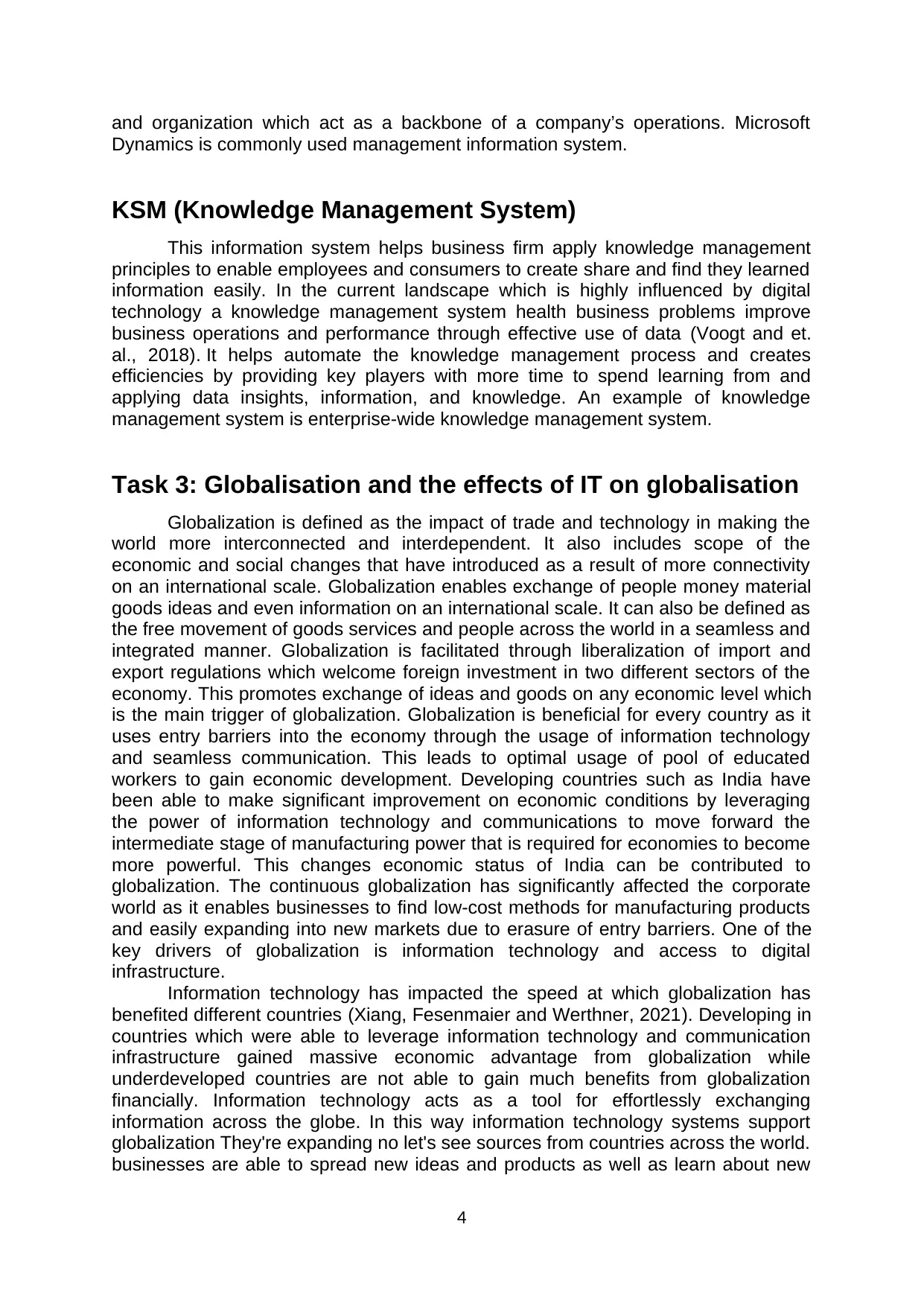
and organization which act as a backbone of a company’s operations. Microsoft
Dynamics is commonly used management information system.
KSM (Knowledge Management System)
This information system helps business firm apply knowledge management
principles to enable employees and consumers to create share and find they learned
information easily. In the current landscape which is highly influenced by digital
technology a knowledge management system health business problems improve
business operations and performance through effective use of data (Voogt and et.
al., 2018). It helps automate the knowledge management process and creates
efficiencies by providing key players with more time to spend learning from and
applying data insights, information, and knowledge. An example of knowledge
management system is enterprise-wide knowledge management system.
Task 3: Globalisation and the effects of IT on globalisation
Globalization is defined as the impact of trade and technology in making the
world more interconnected and interdependent. It also includes scope of the
economic and social changes that have introduced as a result of more connectivity
on an international scale. Globalization enables exchange of people money material
goods ideas and even information on an international scale. It can also be defined as
the free movement of goods services and people across the world in a seamless and
integrated manner. Globalization is facilitated through liberalization of import and
export regulations which welcome foreign investment in two different sectors of the
economy. This promotes exchange of ideas and goods on any economic level which
is the main trigger of globalization. Globalization is beneficial for every country as it
uses entry barriers into the economy through the usage of information technology
and seamless communication. This leads to optimal usage of pool of educated
workers to gain economic development. Developing countries such as India have
been able to make significant improvement on economic conditions by leveraging
the power of information technology and communications to move forward the
intermediate stage of manufacturing power that is required for economies to become
more powerful. This changes economic status of India can be contributed to
globalization. The continuous globalization has significantly affected the corporate
world as it enables businesses to find low-cost methods for manufacturing products
and easily expanding into new markets due to erasure of entry barriers. One of the
key drivers of globalization is information technology and access to digital
infrastructure.
Information technology has impacted the speed at which globalization has
benefited different countries (Xiang, Fesenmaier and Werthner, 2021). Developing in
countries which were able to leverage information technology and communication
infrastructure gained massive economic advantage from globalization while
underdeveloped countries are not able to gain much benefits from globalization
financially. Information technology acts as a tool for effortlessly exchanging
information across the globe. In this way information technology systems support
globalization They're expanding no let's see sources from countries across the world.
businesses are able to spread new ideas and products as well as learn about new
4
Dynamics is commonly used management information system.
KSM (Knowledge Management System)
This information system helps business firm apply knowledge management
principles to enable employees and consumers to create share and find they learned
information easily. In the current landscape which is highly influenced by digital
technology a knowledge management system health business problems improve
business operations and performance through effective use of data (Voogt and et.
al., 2018). It helps automate the knowledge management process and creates
efficiencies by providing key players with more time to spend learning from and
applying data insights, information, and knowledge. An example of knowledge
management system is enterprise-wide knowledge management system.
Task 3: Globalisation and the effects of IT on globalisation
Globalization is defined as the impact of trade and technology in making the
world more interconnected and interdependent. It also includes scope of the
economic and social changes that have introduced as a result of more connectivity
on an international scale. Globalization enables exchange of people money material
goods ideas and even information on an international scale. It can also be defined as
the free movement of goods services and people across the world in a seamless and
integrated manner. Globalization is facilitated through liberalization of import and
export regulations which welcome foreign investment in two different sectors of the
economy. This promotes exchange of ideas and goods on any economic level which
is the main trigger of globalization. Globalization is beneficial for every country as it
uses entry barriers into the economy through the usage of information technology
and seamless communication. This leads to optimal usage of pool of educated
workers to gain economic development. Developing countries such as India have
been able to make significant improvement on economic conditions by leveraging
the power of information technology and communications to move forward the
intermediate stage of manufacturing power that is required for economies to become
more powerful. This changes economic status of India can be contributed to
globalization. The continuous globalization has significantly affected the corporate
world as it enables businesses to find low-cost methods for manufacturing products
and easily expanding into new markets due to erasure of entry barriers. One of the
key drivers of globalization is information technology and access to digital
infrastructure.
Information technology has impacted the speed at which globalization has
benefited different countries (Xiang, Fesenmaier and Werthner, 2021). Developing in
countries which were able to leverage information technology and communication
infrastructure gained massive economic advantage from globalization while
underdeveloped countries are not able to gain much benefits from globalization
financially. Information technology acts as a tool for effortlessly exchanging
information across the globe. In this way information technology systems support
globalization They're expanding no let's see sources from countries across the world.
businesses are able to spread new ideas and products as well as learn about new
4
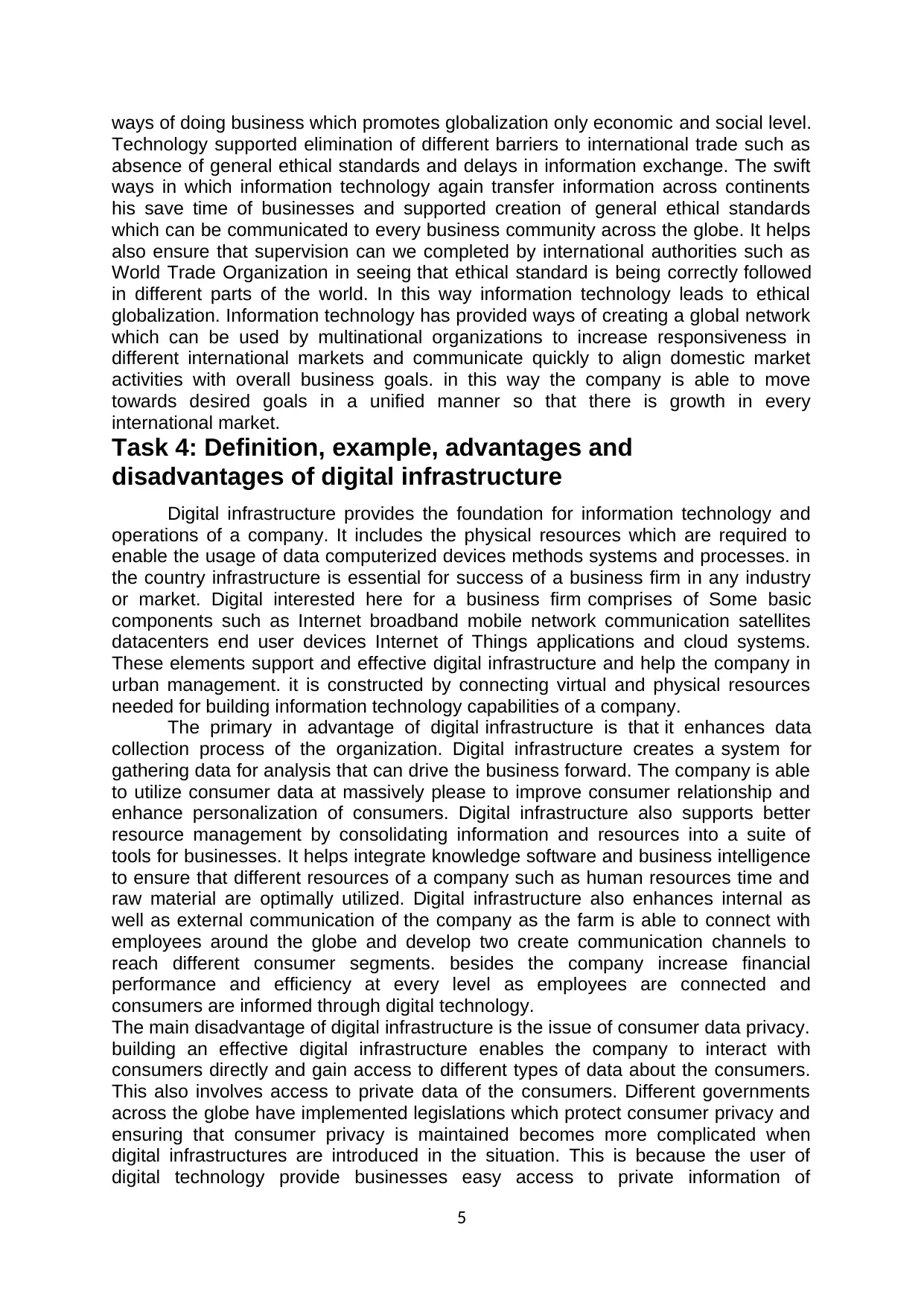
ways of doing business which promotes globalization only economic and social level.
Technology supported elimination of different barriers to international trade such as
absence of general ethical standards and delays in information exchange. The swift
ways in which information technology again transfer information across continents
his save time of businesses and supported creation of general ethical standards
which can be communicated to every business community across the globe. It helps
also ensure that supervision can we completed by international authorities such as
World Trade Organization in seeing that ethical standard is being correctly followed
in different parts of the world. In this way information technology leads to ethical
globalization. Information technology has provided ways of creating a global network
which can be used by multinational organizations to increase responsiveness in
different international markets and communicate quickly to align domestic market
activities with overall business goals. in this way the company is able to move
towards desired goals in a unified manner so that there is growth in every
international market.
Task 4: Definition, example, advantages and
disadvantages of digital infrastructure
Digital infrastructure provides the foundation for information technology and
operations of a company. It includes the physical resources which are required to
enable the usage of data computerized devices methods systems and processes. in
the country infrastructure is essential for success of a business firm in any industry
or market. Digital interested here for a business firm comprises of Some basic
components such as Internet broadband mobile network communication satellites
datacenters end user devices Internet of Things applications and cloud systems.
These elements support and effective digital infrastructure and help the company in
urban management. it is constructed by connecting virtual and physical resources
needed for building information technology capabilities of a company.
The primary in advantage of digital infrastructure is that it enhances data
collection process of the organization. Digital infrastructure creates a system for
gathering data for analysis that can drive the business forward. The company is able
to utilize consumer data at massively please to improve consumer relationship and
enhance personalization of consumers. Digital infrastructure also supports better
resource management by consolidating information and resources into a suite of
tools for businesses. It helps integrate knowledge software and business intelligence
to ensure that different resources of a company such as human resources time and
raw material are optimally utilized. Digital infrastructure also enhances internal as
well as external communication of the company as the farm is able to connect with
employees around the globe and develop two create communication channels to
reach different consumer segments. besides the company increase financial
performance and efficiency at every level as employees are connected and
consumers are informed through digital technology.
The main disadvantage of digital infrastructure is the issue of consumer data privacy.
building an effective digital infrastructure enables the company to interact with
consumers directly and gain access to different types of data about the consumers.
This also involves access to private data of the consumers. Different governments
across the globe have implemented legislations which protect consumer privacy and
ensuring that consumer privacy is maintained becomes more complicated when
digital infrastructures are introduced in the situation. This is because the user of
digital technology provide businesses easy access to private information of
5
Technology supported elimination of different barriers to international trade such as
absence of general ethical standards and delays in information exchange. The swift
ways in which information technology again transfer information across continents
his save time of businesses and supported creation of general ethical standards
which can be communicated to every business community across the globe. It helps
also ensure that supervision can we completed by international authorities such as
World Trade Organization in seeing that ethical standard is being correctly followed
in different parts of the world. In this way information technology leads to ethical
globalization. Information technology has provided ways of creating a global network
which can be used by multinational organizations to increase responsiveness in
different international markets and communicate quickly to align domestic market
activities with overall business goals. in this way the company is able to move
towards desired goals in a unified manner so that there is growth in every
international market.
Task 4: Definition, example, advantages and
disadvantages of digital infrastructure
Digital infrastructure provides the foundation for information technology and
operations of a company. It includes the physical resources which are required to
enable the usage of data computerized devices methods systems and processes. in
the country infrastructure is essential for success of a business firm in any industry
or market. Digital interested here for a business firm comprises of Some basic
components such as Internet broadband mobile network communication satellites
datacenters end user devices Internet of Things applications and cloud systems.
These elements support and effective digital infrastructure and help the company in
urban management. it is constructed by connecting virtual and physical resources
needed for building information technology capabilities of a company.
The primary in advantage of digital infrastructure is that it enhances data
collection process of the organization. Digital infrastructure creates a system for
gathering data for analysis that can drive the business forward. The company is able
to utilize consumer data at massively please to improve consumer relationship and
enhance personalization of consumers. Digital infrastructure also supports better
resource management by consolidating information and resources into a suite of
tools for businesses. It helps integrate knowledge software and business intelligence
to ensure that different resources of a company such as human resources time and
raw material are optimally utilized. Digital infrastructure also enhances internal as
well as external communication of the company as the farm is able to connect with
employees around the globe and develop two create communication channels to
reach different consumer segments. besides the company increase financial
performance and efficiency at every level as employees are connected and
consumers are informed through digital technology.
The main disadvantage of digital infrastructure is the issue of consumer data privacy.
building an effective digital infrastructure enables the company to interact with
consumers directly and gain access to different types of data about the consumers.
This also involves access to private data of the consumers. Different governments
across the globe have implemented legislations which protect consumer privacy and
ensuring that consumer privacy is maintained becomes more complicated when
digital infrastructures are introduced in the situation. This is because the user of
digital technology provide businesses easy access to private information of
5
⊘ This is a preview!⊘
Do you want full access?
Subscribe today to unlock all pages.

Trusted by 1+ million students worldwide
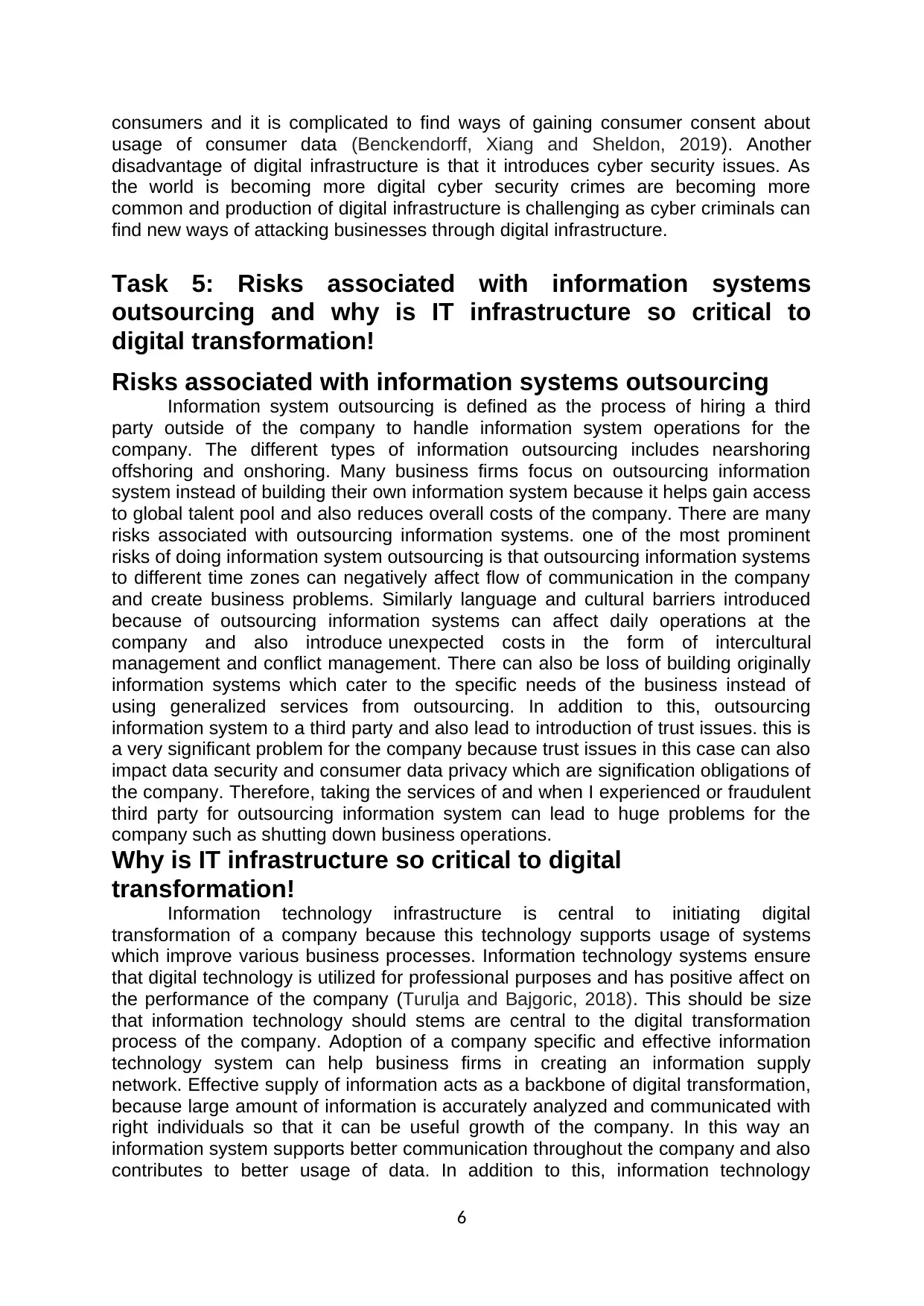
consumers and it is complicated to find ways of gaining consumer consent about
usage of consumer data (Benckendorff, Xiang and Sheldon, 2019). Another
disadvantage of digital infrastructure is that it introduces cyber security issues. As
the world is becoming more digital cyber security crimes are becoming more
common and production of digital infrastructure is challenging as cyber criminals can
find new ways of attacking businesses through digital infrastructure.
Task 5: Risks associated with information systems
outsourcing and why is IT infrastructure so critical to
digital transformation!
Risks associated with information systems outsourcing
Information system outsourcing is defined as the process of hiring a third
party outside of the company to handle information system operations for the
company. The different types of information outsourcing includes nearshoring
offshoring and onshoring. Many business firms focus on outsourcing information
system instead of building their own information system because it helps gain access
to global talent pool and also reduces overall costs of the company. There are many
risks associated with outsourcing information systems. one of the most prominent
risks of doing information system outsourcing is that outsourcing information systems
to different time zones can negatively affect flow of communication in the company
and create business problems. Similarly language and cultural barriers introduced
because of outsourcing information systems can affect daily operations at the
company and also introduce unexpected costs in the form of intercultural
management and conflict management. There can also be loss of building originally
information systems which cater to the specific needs of the business instead of
using generalized services from outsourcing. In addition to this, outsourcing
information system to a third party and also lead to introduction of trust issues. this is
a very significant problem for the company because trust issues in this case can also
impact data security and consumer data privacy which are signification obligations of
the company. Therefore, taking the services of and when I experienced or fraudulent
third party for outsourcing information system can lead to huge problems for the
company such as shutting down business operations.
Why is IT infrastructure so critical to digital
transformation!
Information technology infrastructure is central to initiating digital
transformation of a company because this technology supports usage of systems
which improve various business processes. Information technology systems ensure
that digital technology is utilized for professional purposes and has positive affect on
the performance of the company (Turulja and Bajgoric, 2018). This should be size
that information technology should stems are central to the digital transformation
process of the company. Adoption of a company specific and effective information
technology system can help business firms in creating an information supply
network. Effective supply of information acts as a backbone of digital transformation,
because large amount of information is accurately analyzed and communicated with
right individuals so that it can be useful growth of the company. In this way an
information system supports better communication throughout the company and also
contributes to better usage of data. In addition to this, information technology
6
usage of consumer data (Benckendorff, Xiang and Sheldon, 2019). Another
disadvantage of digital infrastructure is that it introduces cyber security issues. As
the world is becoming more digital cyber security crimes are becoming more
common and production of digital infrastructure is challenging as cyber criminals can
find new ways of attacking businesses through digital infrastructure.
Task 5: Risks associated with information systems
outsourcing and why is IT infrastructure so critical to
digital transformation!
Risks associated with information systems outsourcing
Information system outsourcing is defined as the process of hiring a third
party outside of the company to handle information system operations for the
company. The different types of information outsourcing includes nearshoring
offshoring and onshoring. Many business firms focus on outsourcing information
system instead of building their own information system because it helps gain access
to global talent pool and also reduces overall costs of the company. There are many
risks associated with outsourcing information systems. one of the most prominent
risks of doing information system outsourcing is that outsourcing information systems
to different time zones can negatively affect flow of communication in the company
and create business problems. Similarly language and cultural barriers introduced
because of outsourcing information systems can affect daily operations at the
company and also introduce unexpected costs in the form of intercultural
management and conflict management. There can also be loss of building originally
information systems which cater to the specific needs of the business instead of
using generalized services from outsourcing. In addition to this, outsourcing
information system to a third party and also lead to introduction of trust issues. this is
a very significant problem for the company because trust issues in this case can also
impact data security and consumer data privacy which are signification obligations of
the company. Therefore, taking the services of and when I experienced or fraudulent
third party for outsourcing information system can lead to huge problems for the
company such as shutting down business operations.
Why is IT infrastructure so critical to digital
transformation!
Information technology infrastructure is central to initiating digital
transformation of a company because this technology supports usage of systems
which improve various business processes. Information technology systems ensure
that digital technology is utilized for professional purposes and has positive affect on
the performance of the company (Turulja and Bajgoric, 2018). This should be size
that information technology should stems are central to the digital transformation
process of the company. Adoption of a company specific and effective information
technology system can help business firms in creating an information supply
network. Effective supply of information acts as a backbone of digital transformation,
because large amount of information is accurately analyzed and communicated with
right individuals so that it can be useful growth of the company. In this way an
information system supports better communication throughout the company and also
contributes to better usage of data. In addition to this, information technology
6
Paraphrase This Document
Need a fresh take? Get an instant paraphrase of this document with our AI Paraphraser
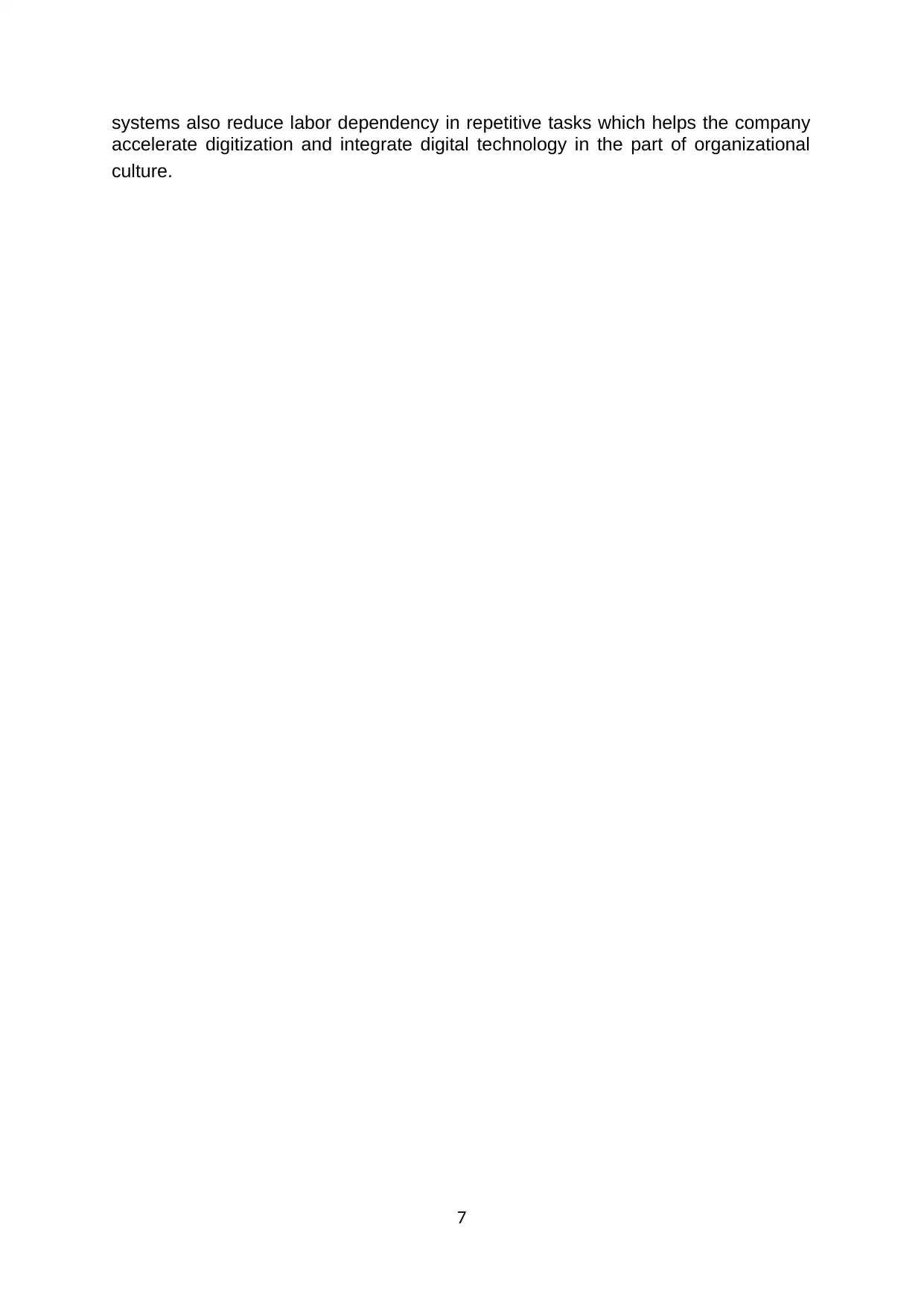
systems also reduce labor dependency in repetitive tasks which helps the company
accelerate digitization and integrate digital technology in the part of organizational
culture.
7
accelerate digitization and integrate digital technology in the part of organizational
culture.
7
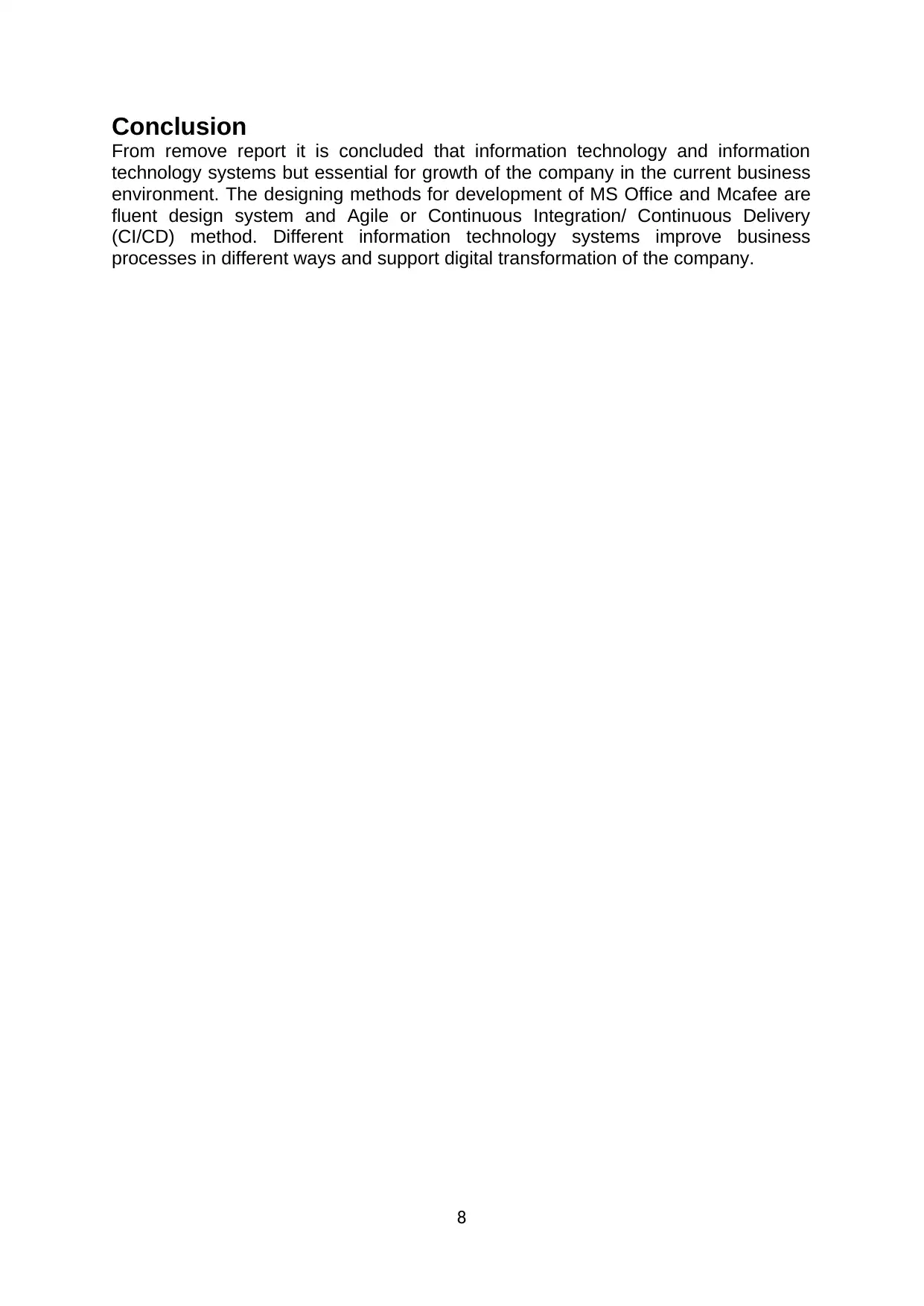
Conclusion
From remove report it is concluded that information technology and information
technology systems but essential for growth of the company in the current business
environment. The designing methods for development of MS Office and Mcafee are
fluent design system and Agile or Continuous Integration/ Continuous Delivery
(CI/CD) method. Different information technology systems improve business
processes in different ways and support digital transformation of the company.
8
From remove report it is concluded that information technology and information
technology systems but essential for growth of the company in the current business
environment. The designing methods for development of MS Office and Mcafee are
fluent design system and Agile or Continuous Integration/ Continuous Delivery
(CI/CD) method. Different information technology systems improve business
processes in different ways and support digital transformation of the company.
8
⊘ This is a preview!⊘
Do you want full access?
Subscribe today to unlock all pages.

Trusted by 1+ million students worldwide
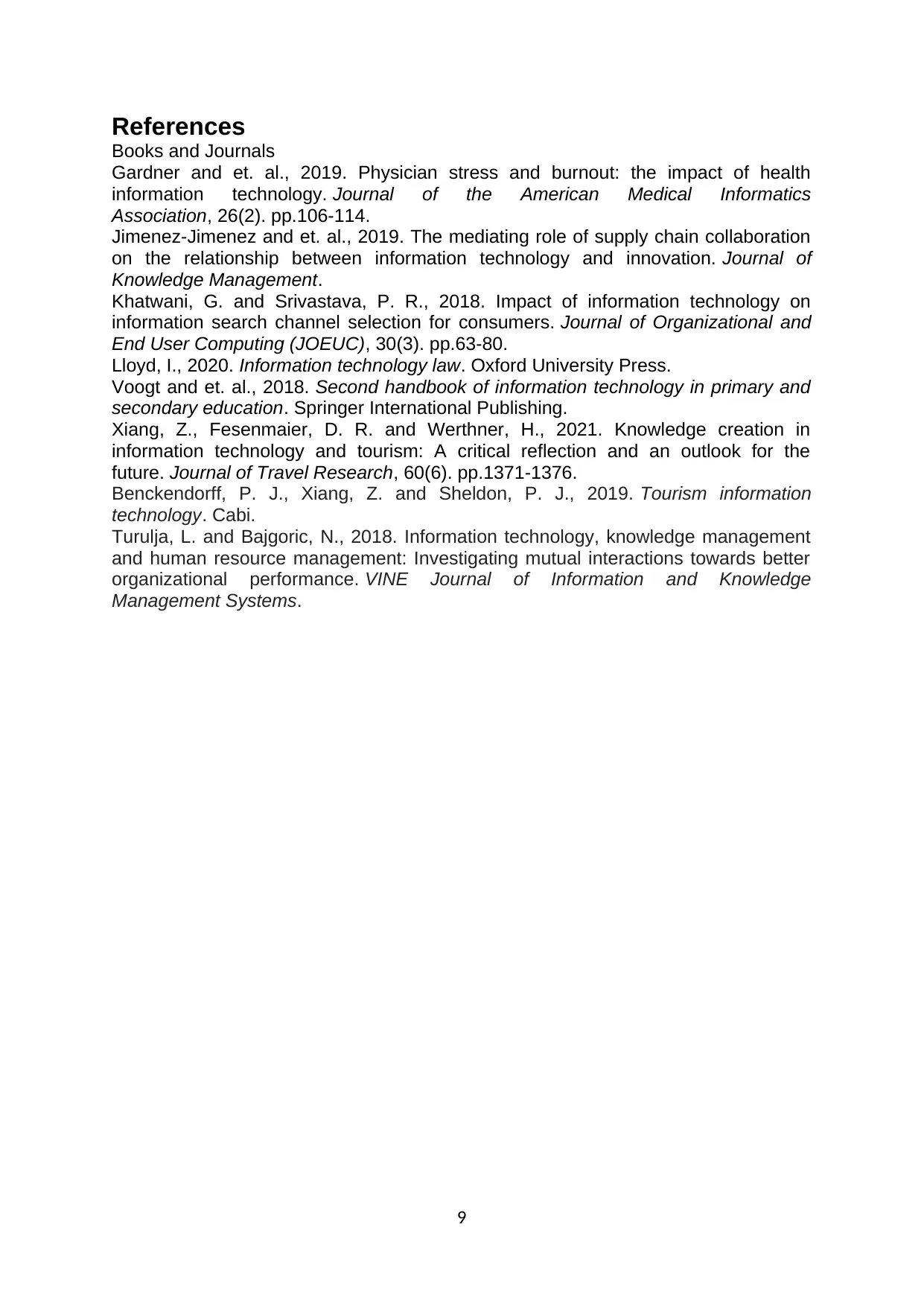
References
Books and Journals
Gardner and et. al., 2019. Physician stress and burnout: the impact of health
information technology. Journal of the American Medical Informatics
Association, 26(2). pp.106-114.
Jimenez-Jimenez and et. al., 2019. The mediating role of supply chain collaboration
on the relationship between information technology and innovation. Journal of
Knowledge Management.
Khatwani, G. and Srivastava, P. R., 2018. Impact of information technology on
information search channel selection for consumers. Journal of Organizational and
End User Computing (JOEUC), 30(3). pp.63-80.
Lloyd, I., 2020. Information technology law. Oxford University Press.
Voogt and et. al., 2018. Second handbook of information technology in primary and
secondary education. Springer International Publishing.
Xiang, Z., Fesenmaier, D. R. and Werthner, H., 2021. Knowledge creation in
information technology and tourism: A critical reflection and an outlook for the
future. Journal of Travel Research, 60(6). pp.1371-1376.
Benckendorff, P. J., Xiang, Z. and Sheldon, P. J., 2019. Tourism information
technology. Cabi.
Turulja, L. and Bajgoric, N., 2018. Information technology, knowledge management
and human resource management: Investigating mutual interactions towards better
organizational performance. VINE Journal of Information and Knowledge
Management Systems.
9
Books and Journals
Gardner and et. al., 2019. Physician stress and burnout: the impact of health
information technology. Journal of the American Medical Informatics
Association, 26(2). pp.106-114.
Jimenez-Jimenez and et. al., 2019. The mediating role of supply chain collaboration
on the relationship between information technology and innovation. Journal of
Knowledge Management.
Khatwani, G. and Srivastava, P. R., 2018. Impact of information technology on
information search channel selection for consumers. Journal of Organizational and
End User Computing (JOEUC), 30(3). pp.63-80.
Lloyd, I., 2020. Information technology law. Oxford University Press.
Voogt and et. al., 2018. Second handbook of information technology in primary and
secondary education. Springer International Publishing.
Xiang, Z., Fesenmaier, D. R. and Werthner, H., 2021. Knowledge creation in
information technology and tourism: A critical reflection and an outlook for the
future. Journal of Travel Research, 60(6). pp.1371-1376.
Benckendorff, P. J., Xiang, Z. and Sheldon, P. J., 2019. Tourism information
technology. Cabi.
Turulja, L. and Bajgoric, N., 2018. Information technology, knowledge management
and human resource management: Investigating mutual interactions towards better
organizational performance. VINE Journal of Information and Knowledge
Management Systems.
9
1 out of 10
Related Documents
Your All-in-One AI-Powered Toolkit for Academic Success.
+13062052269
info@desklib.com
Available 24*7 on WhatsApp / Email
![[object Object]](/_next/static/media/star-bottom.7253800d.svg)
Unlock your academic potential
Copyright © 2020–2025 A2Z Services. All Rights Reserved. Developed and managed by ZUCOL.


